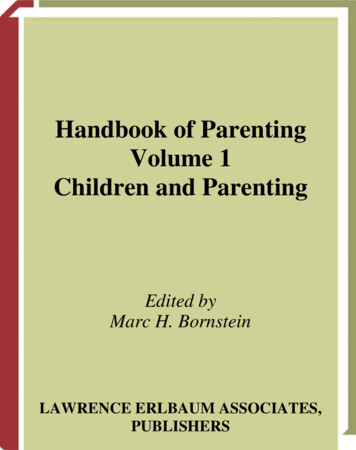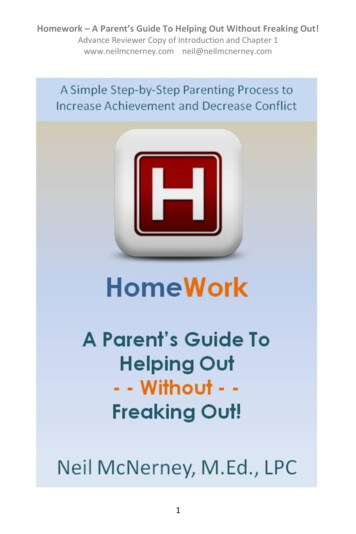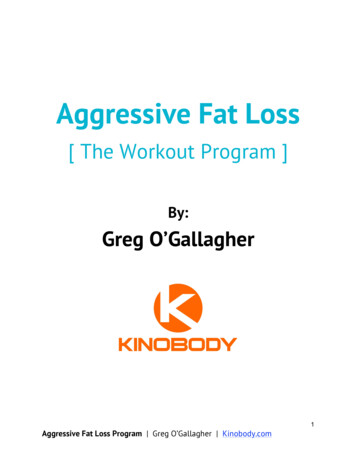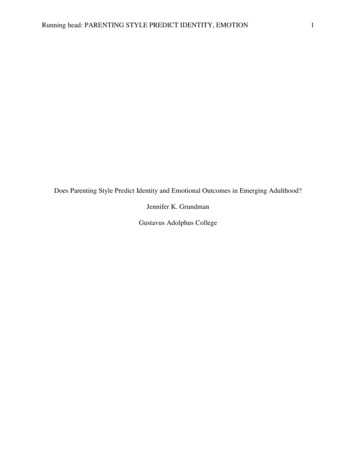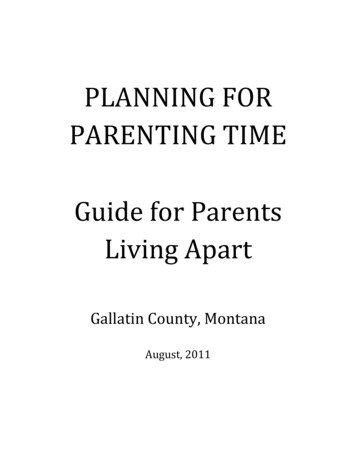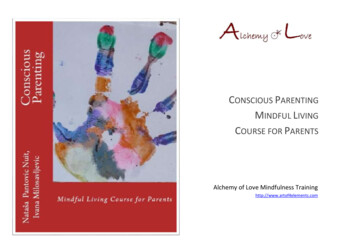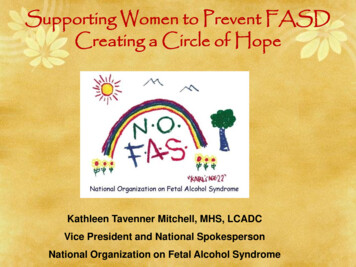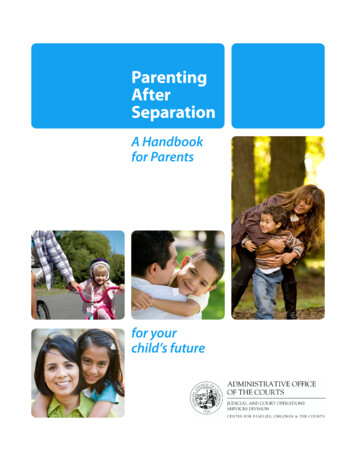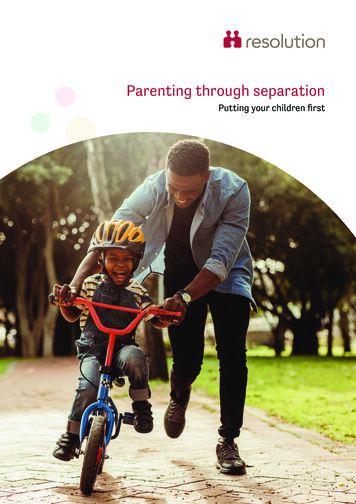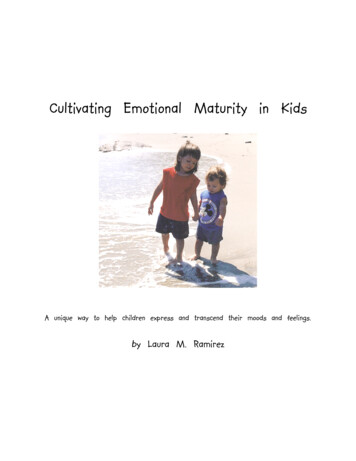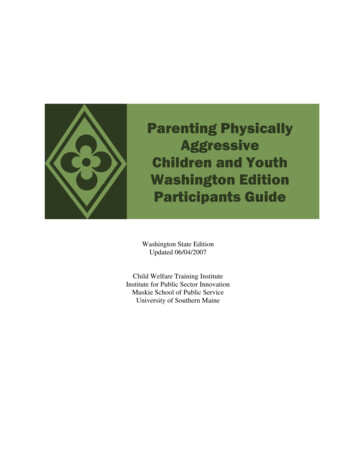
Transcription
Parenting PhysicallyAggressiveChildren and YouthWashington EditionParticipants GuideWashington State EditionUpdated 06/04/2007Child Welfare Training InstituteInstitute for Public Sector InnovationMuskie School of Public ServiceUniversity of Southern Maine
2006 Child Welfare Training InstituteLimited permission is hereby granted by the publisher for the reproduction of ParentingPhysically Aggressive Youth and Children, trainer guide Washington State Edition, for use inconjunction with the training sessions only.All other rights reserved. Subject to the above, neither this book nor any part may be reproducedor transmitted in any form or by any means, electronic or mechanical, including photocopying,microfilming, and records, or by any information storage and retrieval system, withoutpermission in writing from the copyright holder. For more information contact, the ChildWelfare Training Institute at the address below.University of Southern MaineMuskie School of Public ServiceChild Welfare Training Institute45 Commerce Drive, Suite 11Augusta, ME 04330207.626.5200
Table of ContentsTable of Contents . 1Parenting Physically Aggressive Children and Youth . 2Training Goal: . 2Learning Objectives: . 2Unit 1 Laying the Foundation – Review/Refresher of Fundamental Information . 3The Impact of Trauma . 3Washington State Policy on Discipline . 4Contrasting Discipline and Punishment. 6Unit 2 Understanding Anger and Aggression . 8Defining Aggression . 8Physiological changes . 10What Agitation/Escalation Looks Like . 11The Four Levels of Agitation . 12Fidgeting . 12Unit 3 Managing Physically Aggressive Behaviors. 24The Attitude of a Parent . 25Teaching Coping Skills. 27Establishing Structure, Expectations, and Practice Opportunities. 27Positive Reinforcements . 29What are the triggers to the aggressive behavior? . 37Steps to Teaching Interaction . 40Pathways Inventory . 43Adults Can (and Should) Have Expectations . 45Vignettes . 45Connecting the Approaches . 48Restitution . 48Crisis Intervention/Management . 49A Safer Way to Manage my Feelings . 53What Should You Do If You Respond Inappropriately to Your Child‟s Behavior? . 54Unit 4 Self Care . 55Closing: Evaluations, distribution of certificates. 59Parenting Physically Aggressive Children and YouthMaine Child Welfare Training Institute 2007 WA Edition1
Parenting Physically Aggressive Children and YouthTraining Goal:To assist families in understanding and managing physically aggressivebehaviors in children and youth.Learning Objectives:1. Parents will learn that approaches to parenting and managing childrenwith aggressive behaviors depend on the child‟s developmental stage.2. Parents will be able to define aggression in children and youth.3. Parents will develop a greater understanding of the factors thatcontribute to aggressive behaviors in children.4. Parents will learn a variety of techniques that will assist them inmanaging aggressive behaviors.5. Parents will learn some resources and some strategies for self-care toassist them in dealing with aggressive behaviors of children.2Parenting Physically Aggressive Children and YouthMaine Child Welfare Training Institute 2007 WA Edition
Unit1Laying the Foundation – Review/Refresherof Fundamental InformationTrauma has long-term impacts on children. The experience of abuse, neglect,removal from their birth family, has implications that can affect their responses andbehaviors throughout their lifetime. In addition, attachment issues play asignificant role in how children behave and how they respond to adult intervention.The Impact of Trauma[Source: Understanding Traumatized and Maltreated Children: the Six Core Concepts, Bruce D.Perry, MD. The Child Trauma Academy, Houston, TX, 1999]The Human brain is wired by experience. If children experience trauma, abuse,and neglect, their brains will be wired in a way that expects and anticipatesthose outcomes.The brain is malleable. It can change. Change takes time. Children who havebeen abused, neglected or traumatized need literally thousands of positivesensory experiences to change their brain‟s wiring.The brain continues to grow and develop after the third year of life.Teenagers, in particular, have huge window of opportunity to form newconnections within their brain and to rewire those connections.The unique wiring in children who have been traumatized, can and often leadsto significant delays in one or more areas of development.There are youth in care with developmental delays and function at levelsyounger than their actual age.Parenting Physically Aggressive Children and YouthMaine Child Welfare Training Institute 2007 WA Edition3
To illustrate this point, let‟s look at how Fetal Alcohol Syndrome (one example ofprenatal trauma through exposure to alcohol before birth), can affect development.Impact of FAS on a child;Physical developmentCognitive developmentSocial developmentEmotional developmentLearning abilitiesIntrusive, poor judgementBehavior problemsLacking understanding of cause and effectAn FAS18-year old person‟s strengths do not necessarily serve him well.Someone looking at him first notices his size and physical maturity. Because hisexpressive skills are advanced, he presents with an exaggerated level ofdevelopment/capability. Consider his emotional maturity and his social skills –would you let a 6-year old drive a car? Go on a date? Stay alone overnight? Yourdiscipline approaches must match a child‟s stage of development/ comprehension,rather than a chronological age.Past history and experience often explains why children behave in certain waysi.e., food hoarding for the child who has been deprived). Whenever you areworking with children in Departmental Custody, you need to keep in mind theDiscipline policies of the Department. They are included in a handout for yourreview.Washington State Policy on DisciplineAttached is the agreement regarding WA policy on discipline.4Parenting Physically Aggressive Children and YouthMaine Child Welfare Training Institute 2007 WA Edition
Parenting Physically Aggressive Children and YouthMaine Child Welfare Training Institute 2007 WA Edition5
Contrasting Discipline and PunishmentEffective and positive discipline skills are crucial to all parenting. Foster andadopted children often do not react to discipline in the same manner due totraumatic situations. Positive discipline skills are effective at;Protecting and nurturing children‟s physical and psychological well-being.Advancing children‟s development.Meeting children‟s needs.Teaching ways to prevent and solve problems.Maintaining and building the parent/child relationshipHelping children develop self-control and responsibilityProducing desired behaviorThe purpose of punishment is to control, coerce, or shame a child into acting acertain way. The control is external not internal. Child can get negative messagesfrom punishment even when not intended.It is important to keep in mind the child‟s history, developmental stage, and uniquetemperament when disciplining. For example, sending a child to their room for atime out (if in past they were locked in their room for days) might evoke strongfeelings of fear and anxiety.Some guiding principles of positive discipline:Model respectful behaviorMake sure children know what you expect of them, be consistent andreasonableRespond effectively by taking the time to identify the meaning behind thebehaviorChoose consequences which are reasonable and provide learningexperiencesEffective discipline fosters:Foster high self esteemPromote moral developmentIncrease problem solving skills6Parenting Physically Aggressive Children and YouthMaine Child Welfare Training Institute 2007 WA Edition
Some Techniques of Positive DisciplineRestitution: Require child to do something specific ad concrete to make upfor misdeed.Choices: Give them choices of actions as long as outcome is acceptableRedirection: If acting inappropriately encourage alternative activities.Time-out: Have child take a break to calm down. A break in the activity.Usually this is one minute for every year of child‟s age.Time-in: keep them within sight or spend more time with them.Privileges based on behavior: Link child‟s greater independence to goodjudgement and control.Reward positive behavior: Simple acknowledgement of positive behavior.Natural consequences: Outcome when no intervention takes place. Noclean clothes when teen doesn‟t do laundry.Logical consequences: Connects penalty directly to the misbehavior.Point System: Give points for desired behavior. Accumulation of pointsresults in a reward.Choose battles: Sometimes not reacting to or ignoring misbehavior is aneffective response.Parenting Physically Aggressive Children and YouthMaine Child Welfare Training Institute 2007 WA Edition7
Unit2Understanding Anger and AggressionDefining AggressionWhat is Aggression? How do you know when your child is angry or upset?Throw books and toysHits and kicksSpitsStomps aroundHuffs and puffs and acts angry but never tells you whyYellsSlams doorsPunches wallsSwearsShuts down/ doesn‟t talkSelf-abuse/ Self harmPoutsSneaky/retaliatory – instigates so others get into troubleTattlingLying – allegationsStealingBreaking things (Own or someone else‟s)8Parenting Physically Aggressive Children and YouthMaine Child Welfare Training Institute 2007 WA Edition
Vandalism – defacing others‟ propertyCriesThe American Academy of Child & Adolescent Psychiatry states that “Violentbehavior in children and adolescents can include a wide range of behaviors:explosive temper tantrums, physical aggression, fighting, threats or attempts to hurtothers (including homicidal thoughts), use of weapons, cruelty toward animals, firesetting, intentional destruction of property and vandalism.”[Source: Facts for Families, No. 55, Updated March 2001]In adolescents, some relational aggression (ostracizing, spreading a rumor aboutsomeone) plays a distinct role in social status among peers, especially girls. Peersdislike physical aggression less over time; adolescents who have gained popularitywill use both relational and physically aggressive behavior to maintain dominant,influential position within their peer group. So parents and others are battlingintense peer pressure when we attempt to diminish physically aggressive behavioramong adolescents whose social standing is enhanced because of it.[Source: Child Development, Volume 75, Aggression and Social Status by A.H.N. Cillessen and L. Mayeux.Copyright 2004. The Society for Research in Child Development, Inc.]Children and youth who are agitated or aggressive are undergoing physiologicalchanges in their bodies. We will briefly review what the body‟s response is tostress hormones.Parenting Physically Aggressive Children and YouthMaine Child Welfare Training Institute 2007 WA Edition9
Physiological changes[Diagram source: l-Vi/Stress.html]The human body responds to stressors by activating the nervous system andspecific hormones. The hypothalamus signals the adrenal glands to producemore of the hormones adrenaline and cortisol and release them into thebloodstream. These hormones speed up heart rate, breathing rate, blood pressure,and metabolism. Blood vessels open wider to let more blood flow to large musclegroups, putting our muscles on alert. Pupils dilate to improve vision. The liverreleases some of its stored glucose to increase the body's energy. And sweat isproduced to cool the body. All of these physical changes prepare a person to reactquickly and effectively to handle the pressure of the moment.10Parenting Physically Aggressive Children and YouthMaine Child Welfare Training Institute 2007 WA Edition
This natural reaction is known as the stress response. Working properly, the body‟sstress response enhances a person‟s ability to perform well under pressure. But thestress response can also cause problems when it overreacts or fails to turn off andreset itself properly. [Text source: www.kidshealth.org/teen/your mind/emotions/stress.html]Think of the “fight or flight” physiological reaction our bodies have to crises .Because the reaction is automatic, controlled by the sympathetic nervous system,there is no conscious control of the changes in our body during a crisis. Thinkingclearly when stressed, agitated or angry is difficult for most of us - not just children- due to the changes in our body and the intense emotions.Although this stress reaction is out of our control, if we are taught to recognizesigns of agitation and escalation, we can calm ourselves and perhaps slow orinterrupt the process. If we can recognize it in ourselves, this will help us as wework with angry and aggressive children and youth.What Agitation/Escalation Looks LikeKeeping in mind these physiological changes in the human body, let‟s think aboutchildren and youth who become angry and aggressive. Given that there arechanges in the body, there are likely to be recognizable signs that a child or youthis becoming agitated. We will describe agitation through four levels of behaviors„Anxiety,‟ „Defensive,‟ „Aggressive,‟ and „Danger.‟Triggers/AntecedentsAnxiety Behaviors Defensive Behaviors Aggressive Behaviors Danger BehaviorsParenting Physically Aggressive Children and YouthMaine Child Welfare Training Institute 2007 WA Edition11
Agitation is not necessarily a progression of behaviors and reactions; however itcan be. A child can escalate - jump from zero to sixty – that is, go from calm toaggressive behavior - like a rocket. S/he can land anywhere on this continuum.The Four Levels of AgitationLevel OneAnxiety Behavior: the perceived possibility of some threat, or lack of needfulfillment, that is not a threat to survival.Feels Like Heart PumpingShortness of breathTinglingBombardedWorriedProblem is unsolvableLooks Like SweatingPacingTwitchingSounds Like ChatteringStaying on same subjectFidgetingResponse Techniques for Anxiety Behavior: Focus on being supportive and nonjudgmental. Use reflective listening to respond to the content and feelingsbeing expressed. Be positive and reassuring.1. Ask open-ended questions and listen to the answers.2. Respond to both the feelings being expressed and the content beingcommunicated.3. Give non-judgmental feedback that summarizes the person‟s view.4. Offer alternatives in a supportive manner.Examples for Practice (how would you use the above steps to help a childexperiencing anxiety behavior due to the following):Child feels left out by peers.Child has to go to bed earlier than sibling.Child has to do a report in front of class.Child has to have immunizations/ go to the doctor.12Parenting Physically Aggressive Children and YouthMaine Child Welfare Training Institute 2007 WA Edition
The Four Levels of Agitation, ContinuedLevel TwoDefensive Behavior: the person focuses more intently on surviving the crisis,causing their hearing, seeing and thinking to become more focused and narrow.Feels Like Stuck on idea or problemCan‟t move onStill present:Heart PumpingShortness of breathTinglingBombardedWorriedProblem is unsolvableLooks Like Protective of space butquick to crowd othersDoesn‟t seem to listenCan‟t sit stillStill Present:SweatingPacingTwitchingFidgetingSounds Like Rapid SpeechLoudStill Present:ChatteringStaying on same subjectResponse Techniques for Defensive Behavior: Concentrate on turning down theheat. Defensiveness can or will escalate into aggressive behavior unless youintervene. You should try to work at getting through to the sensory (visual andauditory) shutdown.1. Maintain a comfortable distance and use body language and voice tone to gainattention.2. Describe the current behavior and how it differs from usual or baselinebehavior.3. Ask open-ended questions to gather information, or make statements thathelp the person think about their behavior and connect their choices withconsequences.Examples for Practice (how would you use the above steps to help a childexperiencing defensive behavior due to the following):Child has been purposely left out by peers and states, “everyone is out to get me.”Child has to go to bed earlier than sibling and sibling has teased the child about it.Child has done something wrong and gotten caught but won‟t admit it.Child has not done something he promised to do.Parenting Physically Aggressive Children and YouthMaine Child Welfare Training Institute 2007 WA Edition13
The Four Levels of Agitation, ContinuedLevel ThreeAggressive Behavior: Built up energy begins to be released. This is displayed byincessant questioning, refusal to cooperate, and verbal attacks. The person‟ssensors are narrowed and focused on the built up energy.Feels Like High energyStill present:Heart PumpingShortness of breathTinglingBombardedWorriedProblem isunsolvableStuck onidea/problemCan‟t move onLooks Like Sounds Like Non-verbal behaviorProtects personal spaceFace may reddenMuscles tightenMay throw itemsIncessant questioningRefusals to complyVerbal attacksStill present:SweatingPacingTwitchingFidgetingProtective of space but quickto crowd othersDoesn‟t seem to listenCan‟t sit stillStill present:ChatteringStaying on same subjectRapid SpeechLoudResponse Techniques for Aggressive Behavior: The focus should be on movingthe person from emotion (the non-thinking) to content (thinking). Defineappropriate behavior, set limits and give choices. Remember to keep your voicelevels normal (DO NOT get angry along with youth) and maintain a nonthreatening stance.1. Acknowledge the youth‟s behavior.2. Clearly define appropriate behavior and set limits or expectations.3. Ask, “What do you want?”4. If the “want” is reasonable, ask, “Is what you are doing going to get youwhat you want?”5. Give the youth a choice.6. Withdraw and wait quietly.14Parenting Physically Aggressive Children and YouthMaine Child Welfare Training Institute 2007 WA Edition
Examples for Practice (how would you use the above steps to help a childexperiencing danger behavior due to the following):Child yells at peers saying, “I‟m going to get you! I‟ll make you sorry!”Child throws a toy toward sibling and says, “I‟d like to pound your face in!”Child slams door and pounds walls.Child smashes toys or other objects deliberately.Parenting Physically Aggressive Children and YouthMaine Child Welfare Training Institute 2007 WA Edition15
The Four Levels of Agitation, ContinuedLevel FourDanger Behavior: The person‟s energy is focused into fight or flight survivalreaction. There is a high probability of an attempt at threat completion. Theverbal attack becomes very focused and more intense.Feels Like Muscle tensionReady to explodeOut of controlStill present:Heart PumpingShortness of breathTinglingBombardedWorriedProblem isunsolvableStuck onidea/problemCan‟t move onHigh energyLooks Like Sounds Like Feet spaced apartNeck muscles prominentEyes set and glaringFists clenchedThrowing items toward youStill present:SweatingPacingTwitchingFidgetingProtective of space but quickto crowd othersDoesn‟t seem to listenCan‟t sit stillNon-verbal behaviorProtects personal spaceFace is redMuscles are tightMay throw itemsVerbal attack is towardothers, property or selfRagePersistenceStill present:ChatteringStaying on same subjectRapid SpeechLoudIncessant questioningRefusals to complyVerbal attacksResponse Techniques for Danger Behavior: The focus needs to be on safety.1. Take threats seriously.2. Increase the distance between you and youth.3. Have all unnecessary people leave the room.4. Look for escape routes, obstacles in the room to put between the two ofyou.5. Maintain non-threatening body language.6. Stay calm, as sudden actions can precipitate a violent reaction, or panic, in16Parenting Physically Aggressive Children and YouthMaine Child Welfare Training Institute 2007 WA Edition
a dangerous person.7. Follow crisis plan and call for help (911 if necessary).Examples for Practice (how would you use the above steps to help a childexperiencing danger behavior due to the following):Child isChild isChild isChild istrying to push past you to get to peers or sibling to attack.trying to kick in plate glass door.attempting to attack animals or other people in your home.doing major property damage (smashing windshields, etc.)Anger is “a natural and mostly automatic response to pain of one form or another(physical or emotional).” Anger, like our other emotions, is a physiological as wellas an emotional response, in this case to pain or fear. The type of pain does notmatter – only that the pain is unpleasant. And the pain must be accompanied bysome anger-triggering thought, some assessment or perception of a situation thatmakes a person believe that someone else is trying to hurt them (whether or not theperception is accurate). Anger can be triggered by memories of traumatic orenraging events. Anger is always directed at a target, even if the target is one‟sself. And anger, like our other emotions, can vary in intensity from mildlyannoyed to completely enrage.So what happens internally when a person gets angry? Anger is an intense form ofstress. This stimulates the central nervous system and puts the entire body in ageneral state of alert. The body‟s “fight or flight” responses are triggered. Bloodpressure rises. Muscles contract. A child or adult who is already grumpy, irritable,or depressed will become more easily aroused to anger than someone who is not.Anger can also be used as a substitute emotion for pain. Some adults (and manychildren) can makes themselves angry because then they don‟t have to feel pain. Itis better to be angry than to be in pain. And this is a transition that can occurconsciously or unconsciously.Parenting Physically Aggressive Children and YouthMaine Child Welfare Training Institute 2007 WA Edition17
What are the advantages of being angry rather than being in pain? Anger is adistraction. Children who are hurting often think about their hurt and focus on it.Angry people, on the other hand, usually turn their attention outward, to thinkabout hurting or “getting even” with those that have hurt them. Anger is thus areally effective means of not having to recognize and deal with painful emotionsand feelings, with fear and vulnerability.A sense of self-righteousness that is often associated with anger can temporarilyboost self-esteem. It is far more satisfying to feel angry than to acknowledgepainful feelings of fear or vulnerability. Instead of feeling afraid or vulnerable,anger can make us feel powerful and in control of what can be frighteningsituations.So why is anger a problem?It‟s not, depending on how it‟s managed. In fact, the survival instincts that angertriggers can be crucial in dangerous situations. Getting the real feelings underlyingthe anger out in a healthy way, dealing with them, facing them head-on, seems tobe the key to overcoming the long-term potential effects of continuous anger.Constant stress and anger, and the physiological reactions that go along with thosefeelings, can lead to headaches, cramps, insomnia, and more serious physicalailments, including heart disease, colitis and gastrointestinal disorders.What are the other problems associated with anger? People who are angry andwho lash out at others can end up in jail, ostracized from their peers, fired fromtheir jobs, suspended or expelled from their schools, and can spiral into depressionand anger cycles that can become overwhelming.Our goal is to help children appropriately express, and not suppress, their anger.We need to teach children to express their anger in ways that let others know howthey are feeling, while being respectful of themselves and others. Children need tolearn the difference between being assertive and being aggressive, in manyinstances.18Parenting Physically Aggressive Children and YouthMaine Child Welfare Training Institute 2007 WA Edition
At the same time, we want to make sure that children understand that expressingtheir anger is not only OK, it‟s healthy – but that there are appropriate andinappropriate ways to do so. Suppressing anger can lead to health issues and/ordepression.What helps? What techniques are recommended for adults and kids who areangry? What are some strategies to reduce anger and its negative effects?1. Relaxation techniques:Deep breathing – from the diaphragm. If a child doesn‟t know how tobreathe from his or her diaphragm, have them lay on their back on the floor.Ask them to breathe in and out in a way that makes their tummy go up anddown. This is the easiest way to determine if someone is breathing fromtheir diaphragm. It doesn‟t mean that children always have to lie on thefloor when they are angry. But it can be a technique that they use to gain“muscle memory” for deep breathing. Often a child‟s deep breaths are justbreathing from their chest – and those are not relaxing in the same way thatdiaphragm breathing can be.Slow repetition of a calming word while deep breathing can help, as cancounting.Visualization can help to ward off intense anger.Calming exercises, such as those in yoga, are helpful in managing stress andreducing the intensity of angry feelings.2. Problem solving:Help a child identify the circumstances or feelings that are making themangry. Then help them come up with some ideas that can make thosecircumstances or feelings less painful or threatening. For example, if a childis really mad at his birth parents, how can he express how he or she isfeeling in a way that is OK and healthy? Some ideas (will need to adjustdepending on the child‟s emotional age).Parenting Physically Aggressive Children and YouthMaine Child Welfare Training Institute 2007 WA Edition19
Typing the letter to nowhere. One technique that is helpful for children toexpress their anger is to allow them to sit down at a computer and compose aletter to the person at whom they are angry. The rules are simple. They areallowed to write ANYTHING at all in this letter. They can write how theyfeel, why they‟re mad, what they wish they could do about it, even use swearwords if they want. The catch is this – they are not allowed to print theletter, to save the letter, or to send the letter. When they have “vented,” theymust erase the letter. This allows children to gather their thoughts, expresstheir feelings, and get the feelings out, rather than keep them bottled upinside.Write, Don‟t Fight. Encourage kids to journal their emotions, to learn toexpress them with words, in a way that is not harmful.Sometimes kids need some immediate physical outlet for that rush ofadrenaline they are feeling. If physical activity or play is not an option, oris not safe, have the child tear up old telephone books. They can see howmany pages they can tear at a time. This is a directed way to use theirphysical anger safely and appropriately, and other than a mess, harmsnothing. The books are still recyclable even after they have been torn.For very young children who are having trouble controlling their urge to beaggressive, directing that to a safe outlet during the process of teaching themto manage their anger more constructively can be a big help.Now, when the child has calmed down after expressing his or her rage through oneof these approved techniques, h
Understanding Anger and Aggression Defining Aggression What is Aggression? How do you know when your child is angry or upset? Throw books and toys Hits and kicks Spits Stomps around Huffs and puffs and acts angry but never tells you why Yells Slams doors Punches walls Swears Shuts down/ doesn‟t talk Self-abuse/ Self harm Pouts
